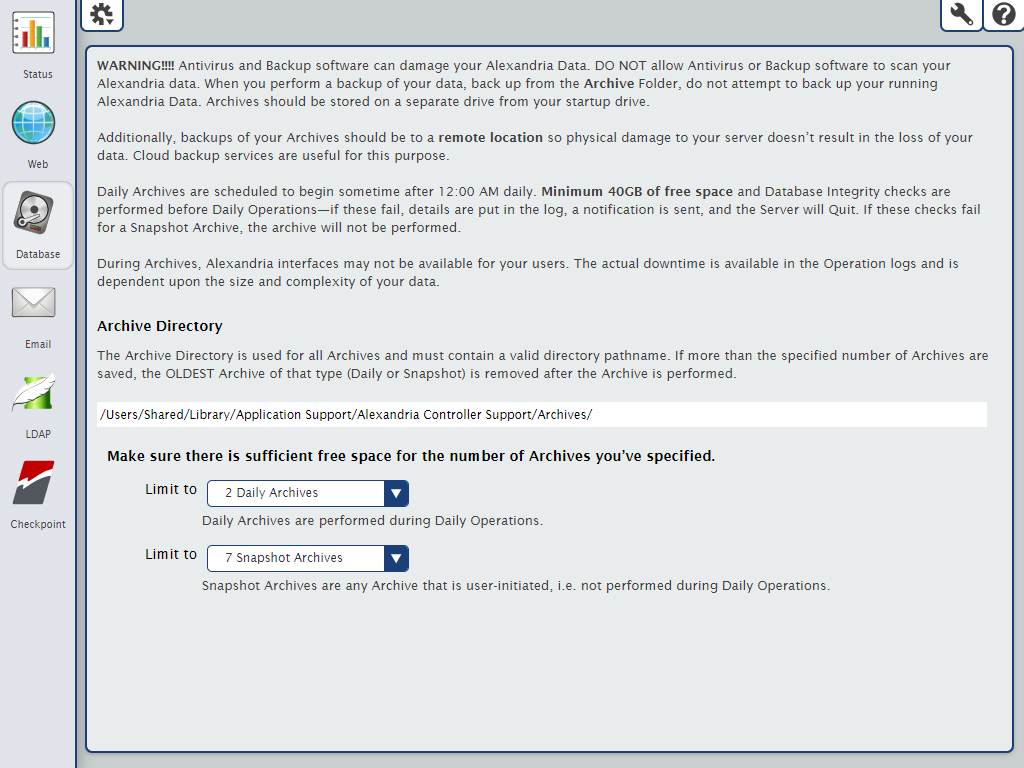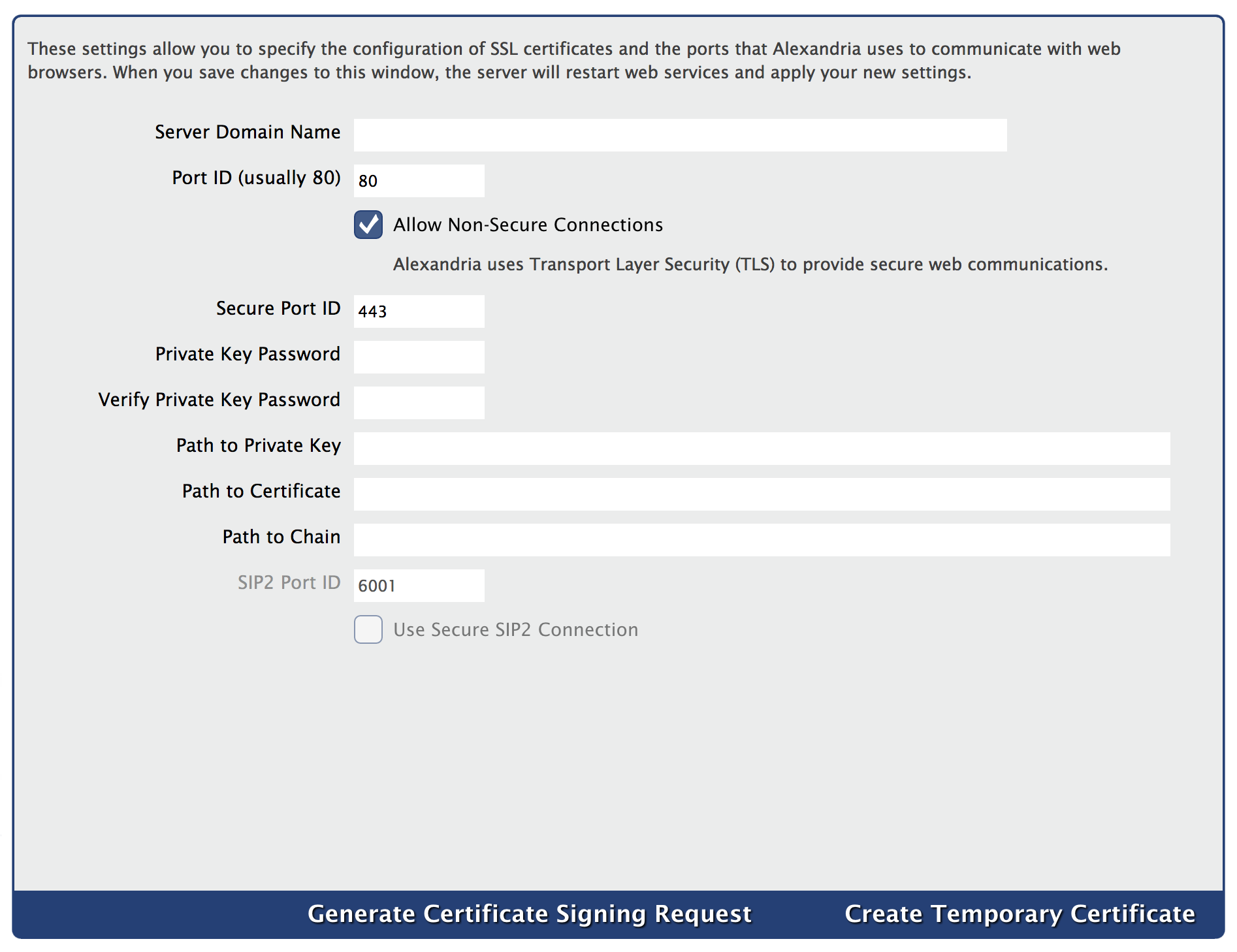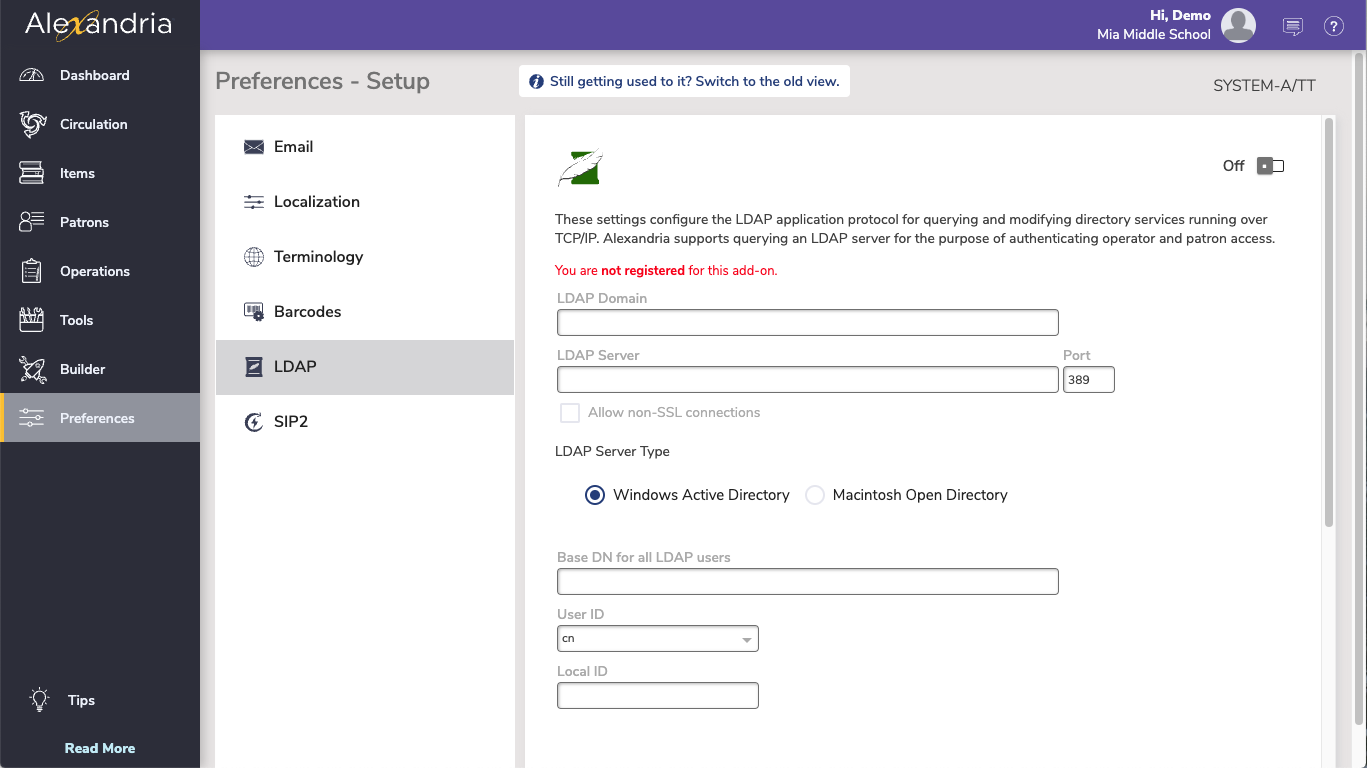Contents
If you are self-hosted, see Self Hosted for the information you need.
This page will NOT be migrated to the new Alexandria Support Center and will instead be archived.
Administration Settings
/admin
Administration settings are high-level preferences intended for network administrators or IT support departments when hosting an Alexandria Controller.
See Controller Administration.
Old Administration
Tools > Administration > Email
To send email reminders, such as the Overdue Items Notice, you will need to configure how Alexandria communicates with your library's email server. Alexandria's email system is designed to potentially cope with hundreds of emails being sent (or resent) over many machines at the same time.
Before you get started, make sure you have a valid email address on record for an administrator-level operator and your library's site contact.
MultiExcerpt named Settings was not found -- Please check the page name and MultiExcerpt name used in the MultiExcerpt-Include macro
Use Gmail As Your SMTP Server
MultiExcerpt named Using Gmail As Your SMTP Server was not found -- Please check the page name and MultiExcerpt name used in the MultiExcerpt-Include macro
What happens if an email fails to send?
If a send fails, the next resend time is generated by adding a random value between 3 and 9 minutes, spreading out the resend times so all the undelivered email still in the “short range” period isn't sent at the same time. If a send hasn't succeeded by the end of the “short range” period, the program will generate new send times using random values between 60 and 90 minutes. If a send still hasn't succeeded after 100 hours the email is discarded and a “return-to-sender” email will be sent.
LDAP Preferences
SYSTEM-A/TT
This page has been moved to https://support.goalexandria.com/ldap-preferences/
LDAP supports user-authentication for open or active directories.
Lightweight Directory Access Protocol (LDAP) is an application protocol for querying and modifying directory services running over TCP/IP. Alexandria supports user-authentication using existing log-on credentials maintained on a separate directory server. With LDAP enabled, administrators can now choose to manage these credentials on a central LDAP server as these credentials may change frequently and often need to be standardized across many different systems. A permanent record must exist locally in the Alexandria database for all patrons and operators that use the system however their log-on credentials can be managed outside of Alexandria on your LDAP server directly.
Note that LDAP is an add-on that requires registration.
Operator usernames and barcodes must be unique. Please make sure your Alexandria patrons do not have the same barcode as an operator.
How Does it Work?
When a user enters credentials in any login dialog, COMPanion software will first check if they are Alexandria credentials and try to find a match. If no match is found, the credentials will be sent to the specified LDAP server in the form of a BIND. If the BIND is successful, the software will locate the user's record within the local database by searching the information returned in the specified Local ID field from the LDAP server. Either way, once the record is found, the user will be logged in.
Settings
If you are a Centralized Catalog these setting will apply to all sites within your controller.
Enable LDAP
Click this toggle.
LDAP Domain
Enter the name of your LDAP domain, such as yourdomain.com. The domain name is used in conjunction with sAMAccountName to produce a complete userPrincipalName.
LDAP Server
Enter the full name of the LDAP server, such as yourdomain.com. This is the host address of the LDAP server for network communication.
Allow Non-Secure Connections (optional)
Check this box if you would like Alexandria to use non-TLS connections when it cannot make an TLS connection.
We highly recommended that you secure communications with the LDAP server by requiring TLS. TLS configuration is performed at the system level. When these settings are correctly configured for secure communications with your LDAP server, Alexandria will be able to communicate with the LDAP server securely.
LDAP Server Type
Select Microsoft Active Directory or macOS Open Directory.
Base DN for all LDAP Users
Enter a DN that matches all the users, i.e. cn=users,dc=ldap,dc=yourdomain,dc=com.
Multiple Base DNs can be specified if separated by semicolons, i.e. cn=staff,ou=COMPanion,dc=demo,dc=goalexandria,dc=com;cn=student,ou=COMPanion,dc=demo,dc=goalexandria,dc=com.
User ID
Select the User ID from the dropdown menu. This is the LDAP login name; for an Open Directory, this is typically uid (i.e. “uid=yourlogin"). For an Active Directory this is typically sAMAccountName or userPrincipalName.
Local ID
Enter the LDAP database username that contains the patron username or patron barcode in Alexandria in the Local ID field. This must be one of the users' LDAP attributes; common attribute names include uid, uidNumber, givenName, cn, and others.
Test Login
Enter a username and password to test your settings. Since the test password is not encrypted, we suggest using a non-administrative login for this test. Unlike other logins, it can be used and configured only on the LDAP server; no actual operator-level login is required.
Click Test to continue. It will attempt to log into the LDAP server using the settings and credentials you've entered. LDAP cannot be enabled until the test is successful. If any of your settings are invalid, the test may stall for several minutes before it fails. Check your settings and test login, then try again.
Once the test is successful, click Save in the upper right corner of the window to save your settings.
More LDAP Testing
If configured correctly, your users should be able to log into Alexandria using the same login credentials as configured on the directory server for their account. However, sometimes difficulty arises. In these cases, verify your preferences settings and test whether the Base DN and other information you have specified is accurate to your configuration.
We have found that Active Directory configurations seem to prefer binds using the user's CN while OSXs Open Directory prefers the uid (i.e. user identification). The use of ldapsearch tool is suggested. For example:
ldapsearch -x -v -H ldap://LDAP.yourdomain.com -b"cn=users, dc=LDAP, dc=yourdomain, dc=com" -D"cn=testing user id, cn=users, dc=LDAP, dc=yourdomain, dc=com" -w the users password -ZZ
Non Secure Connection Testing
The -ZZ parameter requires successful connection utilizing StartTLS over port 389. If you have selected to Allow Non-Secure Connections, omit this in your testing with ldapsearch as well.
Alternately, ldp.exe can be utilized for testing in a Windows environment.
Checkpoint ILS is being discontinued due to a lack of interest.
Checkpoint ILS Preferences
Preferences > Setup > Checkpoint ILS SYSTEM Preference
SHARED with Textbook Tracker
Configure these settings if you are using the Checkpoint ILS (Intelligent Library System) security system to enhance your SIP2 protocol. Remember, this should only be enabled if Checkpoint's SIP2 hardware is in use (SIP2 hardware is not interchangeable between manufacturers). The technician installing your Checkpoint system should be able to configure these settings for you.
Make sure all SIP2 settings are correct and that you have an FTP server running on the same machine as your Alexandria Data Station. The ILS server will place an inventory file on your Data Station. If you are not running an FTP server on your Data Station, the inventory file will need to be placed manually.
Checkpoint ILS settings are available to those running a Centralized Catalog or a Distributed Catalog, regardless if it’s under a Controller or an independently operated Data Station. These settings also appear for those benefiting from our Cloud-Hosted services. Note: In a Centralized Catalog, these settings will apply to all sites.
Settings
Enable Checkpoint ILS
This box should only be enabled if Checkpoint's SIP2 hardware is in use.
Inventory File
Enter the directory for the ILS server to place the inventory file it creates. If the ILS server has not yet created an inventory file, an empty file (of the same name and path) should be created.
Synchronization Folder
As part of the Checkpoint ILS system Alexandria will create a synchronization file, co_cache.txt, that contains a list of barcodes for each item that is currently outside of the library (checked out). This file is placed inside the synchronization folder you specify here.
ILS Server Address
Enter the web address of the ILS FTP server you're trying to connect to. An FTP address looks a lot like an HTTP (website) or IP address, except it uses the prefix ftp:// instead of http:// and can be any combination of letters and numbers.
ILS FTP Path
Enter the directory path of the ILS FTP server where Alexandria will send its data. If you get an error message when trying to connect, be sure to check your FTP path. Default is / .
FTP Username
Enter the username used to access the ILS FTP server.
FTP User Password
Enter the password used to access the ILS FTP server.





